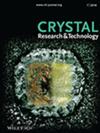Synthesis of FeVO4 Nanoparticles and Sensing Performance for Ethanol Gas under Different Solution pH
IF 1.9
4区 材料科学
Q3 CRYSTALLOGRAPHY
引用次数: 2
Abstract
FeVO4 nanoparticles are synthesized by the hydrothermal method. The effect of micromorphology under different pH conditions is investigated. Their microstructure, morphology, and chemical composition are analyzed by X‐ray diffraction (XRD), scanning electron microscopy (SEM), X‐ray photoelectron spectroscopy (XPS), Raman spectroscopy, and N2 adsorption–desorption. The results showed that an increase in pH leads to agglomeration of the material. The effect of different pH conditions on the gas‐sensitive performance of FeVO4 is subsequently investigated, and the best response performance of the FeVO4 sensor is achieved at a pH of 3. The consequences showed that the FeVO4 sensor has a response of 3.383 to 100 ppm ethanol gas, with the response and recovery time of 1 and 7 s. The response cycle test has proved that FeVO4 has good stability. Analyzed in conjunction with the characterization results, the oxygen vacancies on the surface of the nanoparticles not only improve the electronic conductivity but also provide active sites for the adsorption of gases, which helps to improve the sensitivity of the material to gases.FeVO4纳米颗粒的合成及其在不同溶液pH下对乙醇气体的传感性能
采用水热法制备了FeVO4纳米颗粒。考察了不同pH条件对微形貌的影响。通过X射线衍射(XRD)、扫描电子显微镜(SEM)、X射线光电子能谱(XPS)、拉曼光谱和N2吸附-脱附分析了它们的微观结构、形态和化学成分。结果表明,pH的增加会导致材料的结块。研究了不同pH条件对FeVO4气敏性能的影响,发现pH为3时FeVO4传感器的响应性能最佳。结果表明,FeVO4传感器对100 ppm乙醇气体的响应为3.383,响应时间为1 s,恢复时间为7 s。响应周期试验证明了FeVO4具有良好的稳定性。结合表征结果分析,纳米颗粒表面的氧空位不仅提高了电子导电性,而且为气体的吸附提供了活性位点,有助于提高材料对气体的敏感性。
本文章由计算机程序翻译,如有差异,请以英文原文为准。
求助全文
约1分钟内获得全文
求助全文
来源期刊
自引率
6.70%
发文量
121
审稿时长
1.9 months
期刊介绍:
The journal Crystal Research and Technology is a pure online Journal (since 2012).
Crystal Research and Technology is an international journal examining all aspects of research within experimental, industrial, and theoretical crystallography. The journal covers the relevant aspects of
-crystal growth techniques and phenomena (including bulk growth, thin films)
-modern crystalline materials (e.g. smart materials, nanocrystals, quasicrystals, liquid crystals)
-industrial crystallisation
-application of crystals in materials science, electronics, data storage, and optics
-experimental, simulation and theoretical studies of the structural properties of crystals
-crystallographic computing

 求助内容:
求助内容: 应助结果提醒方式:
应助结果提醒方式:


